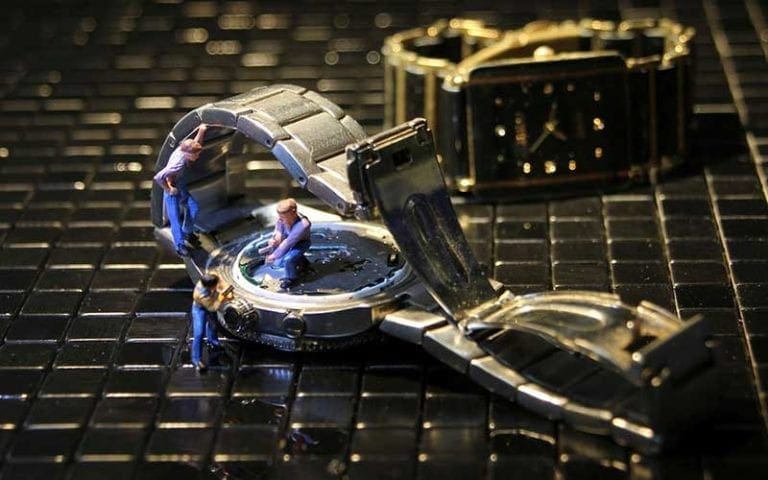Digital vs Analog Watch: Which Is Better?
On July 9, 1916, the New York Times noted a peculiar European fashion trend: bracelets with clocks on them. The paper thought it was just a silly fad…until two years into WWI, when the proliferation of telephones and signal services in warfare made wristwatches an indispensable choice.
We’ve come a long way since that silly fad.
Watches have transformed from a bracelet with a clock into a smartphone around your wrist. Even so, the debate between digital and analog watches is alive and well as buyers continue to look for timeless timepieces.
If you’re debating a digital vs analog watch, here’s what you need to know to make the right call for you.
Key Takeaways from this article:
- There are two main types of watches: analog and digital.
- Analog watches use mechanical movements or quartz crystals to display time.
- Digital watches use electronic displays to show time in numerical form.
- Analog watches are often associated with luxury and precision.
- Digital watches are more affordable and have additional features like alarms and timers.
- Analog watches have a classic and timeless design, while digital watches are more modern and versatile.
- The choice between analog and digital watches depends on personal preference and intended use.
Digital vs. Analog Watch
First, the basics.
An analog watch is what you think of when you picture a watch–a classic watch face with numbers or numerals and hands that march in circles to mark the time.
The first commercial electronic digital watch was introduced by Hamilton in 1972, retailing for a crisp $2,100, though by 1980 they could be found in cereal boxes as free giveaways. The key feature of a digital watch is how it displays time–electronic displays showing minutes and hours rather than the continuous quantity shown on analog watches.
Pros and Cons of a Digital Watch
Digital watches have evolved a lot since the power-hungry 1972 Hamilton model to include a variety of features. Like the Casio Game-10, better known as the time in 1980 when watchmakers justified a profitable price by including a handheld game on the watch in perhaps the most 1980s move they could have made.
Fortunately, digital watches have come a long way since handheld games and now include a variety of great features. Since smartwatches and classic digital watches have a different feature set, we’re not counting smartwatches as digital watches here.
Pros
The biggest pro of digital watches is their battery life.
On average, a new analog watch lasts two years on a battery, while a new digital watch can last four to five years. This depends on how many battery-draining features you use (like a backlit screen) and how often you use them, but a digital watch doesn’t have to power gears to turn the hands.
Another key benefit of digital watches is precision. Since you’re not dealing with hands and gears, it’s easy to ensure a digital watch keeps time. Plus, it can give precision down to hundredths of a second, which is why digital watches are so popular with athletes.
Because they’re easier to produce, digital watches are usually cheaper than the average analog watch. Oh, and they’re easier to read.
Cons
The biggest downside of digital watches is their casualness.
In general, digital watches are considered way more casual than analog watches. And while you can certainly find a good-looking digital watch, it’s pretty much impossible to find one that can be called elegant or work-appropriate for your nine-to-five office job. You’re more likely to find digital watches on the wrists of runners, hikers, and other folks who need a workhorse more than a prize pony.
You can skate on this criteria if you count a smartwatch as a digital watch, but again, your classic digital watch and a smartwatch have a different feature set and are considered two different things.
Pros and Cons of an Analog Watch
While we’ve made a lot of advancements in timekeeping technology, the analog watch has held strong since 1916. In fact, analog watches still dominated the watch market in 2020 and are expected to hold their lead in future years.
Pros
There are watches, and then there are watches. The former tells you what time it is. The latter tells the world what kind of person you are. Watches are almost exclusively analog.
Digital watches are made for efficiency, but analog watches are made for craftsmanship. Every detail matters in an analog watch, from the hands to the face to the watch clasp. There’s something ineffably elegant about an analog watch, something in even a basic face that hearkens to quiet workshops of Swiss masters.
Because of their formality and classic design, analog watches are the watch to reach for at work, special events, and formal occasions. You seem more professional in an analog watch than a digital one.
Plus, an analog watch is made to do one thing: tell time. That means you’re less reliant on your cellphone to tell time, and you have on less distracting screen in your life.
Cons
The biggest downside of analog watches is precision timing. A master watchmaker can wind your watch perfectly, but you’ll never get quite the same level of precision you might see in a digital model.
Also, because analog watches do one job only (tell time) you don’t get other features that might be handy in a timepiece, like an alarm. Many basic digital watches include those features as a matter of course.
Analog or Digital Watch: Which is Right For You?
The right watch depends on what you want from a watch.
If you want a workhorse designed to be a precision instrument, something that can get rough and tumble without batting an eye, a digital watch is a great choice.
On the other hand, if style and professionalism matter more to you than surviving a marathon, analog watches never go out of style. As a rule, if you need a work watch for any sort of office job, an analog watch is the right fit.
Watch Buying Tips
Shopping for a new timepiece? There are a few tips for buying a watch that you should keep in mind, particularly for analog watches.
First, consider the movement of the watch, i.e. the inner mechanisms that make a watch’s hands sweep. This is fundamental to how it works and how it keeps time. There are three types of movement:
- Mechanical
- Automatic
- Quartz
Mechanical watches have movement powered by a hand-wound mainspring rather than a battery. For many, this is the creme de la creme of watches, since mechanical movement is the traditional watch pedigree and craftsmanship.
Automatic watches also use a mainspring, but the user doesn’t have to hand-wind the watch to keep it ticking. The watch winds itself using your movement throughout the day. This gives you the same engineering and character, though it does make the watch more sensitive to the environment.
Most average Joes wear quartz watches, i.e. watches powered by a small electrical battery. No winding is required. And if the watch dies, you just have to swap in a new battery. This makes them way more accurate.
You should also consider complications (those extra little dials on some watches). They’re not as necessary in the smartphone era, but some users love the look and added functionality.
Conclusion:
In the world of watches, the debate between digital and analog continues. Digital watches have come a long way since their introduction in 1972, offering features like extended battery life and precision timing. However, they are often considered more casual and less suitable for formal occasions.
On the other hand, analog watches exude elegance and are perfect for work or special events. While they may lack some of the features of digital watches, they offer a timeless style.
Ultimately, the choice between digital and analog depends on individual preferences and needs. Whether you prioritize durability and functionality or style and professionalism, there is a watch out there for everyone.
Frequently Asked Questions (FAQ)
1. What is a digital watch?
A digital watch is a type of timepiece that displays the time in numerical format, usually using an electronic display.
2. What is an analog watch?
An analog watch is a type of timepiece that indicates time by hands rotating around a dial, typically divided into hours, minutes, and sometimes seconds.
3. What is quartz?
Quartz refers to the crystal used in watches that provides reliable timekeeping through its piezoelectric properties.
4. What is an analog timepiece?
An analog timepiece is another term used to describe an analog watch, where time is indicated by the motion of hands on a dial.
5. What is a digital timepiece?
A digital timepiece is a synonym for a digital watch, displaying the time using numerical digits on an electronic screen.
6. What is the difference between analog and digital?
The main difference is how the time is displayed. An analog watch uses hands rotating on a dial, while a digital watch shows the time in numerical format on a screen.
7. Can a watch have both analog and digital features?
Yes, there are watches that have both analog and digital displays. These types of watches are commonly known as analog-digital watches.
8. What is a mechanical watch?
A mechanical watch is a type of timepiece that uses a complex system of gears and springs to keep time, relying on manual winding or automatic mechanisms.
9. What is quartz movement?
Quartz movement refers to the mechanism used in quartz watches, where an electrical current is applied to a quartz crystal to generate accurate timekeeping.
10. What is a digital display?
A digital display is the screen or panel on a watch that shows the time using numerical digits, typically in an electronic format.
Find Your Perfect Watch
Once you’ve made the choice between a digital vs analog watch, you’re ready to spring for your first (or next) watch. That’s where we can help, providing high-quality craftsmanship and unbeatable style at prices that work for your budget.
If you’re ready for your new favorite watch, click here to check out some of our bestselling watches.






